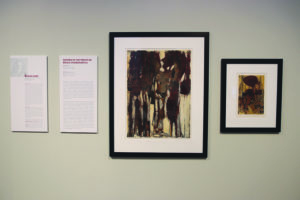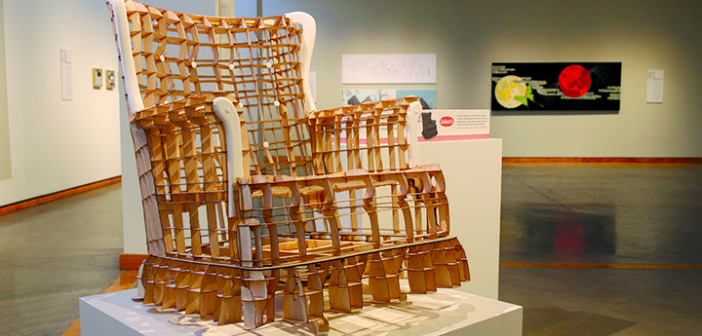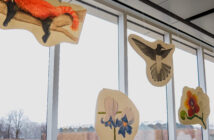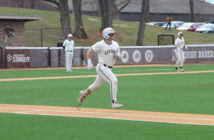
This piece is from Susan Kart, a professor in both the department of art, architecture and design and the Africana Studies program, taken on Feb 3., 2020, at Zoellner Arts Center. The Art, Architecture, and Design Faculty Exhibition’s opening reception took place on Jan. 28, 2020. (Ankit Shingala/B&W Staff)
The 15 artists and professors who mold the department of art, architecture and design collectively contributed to a faculty exhibition in the main gallery at the Lehigh University Art Galleries in Zoellner Arts Center.
“The exhibition reveals the research our faculty members are doing, and all the shapes and forms that it takes,” said William Crow, professor of practice and director of the Lehigh University Art Galleries. “The work is very diverse because the department is very diverse.”
Each artwork bears the touch of its maker.
The exhibition unfolds with an avant-garde piece of furniture from Wesley Heiss, associate professor of product design. He reconstructed a chair like a mechanical puzzle, from insertable, flat balsa sections.
An abusive family member died in that same chair. For Heiss, it’s about transforming emotional baggage into craftsmanship.
Amy Forsyth, associate professor of design, elevates the average jewelry box to what resembles a tree bark, with slabs of wood sliced up and reassembled.
Professor Anthony Viscardi employs an abstract model as his starting point. In one piece, mirrors are curved, metal sheets are scattered, and scraps of basswood are fragmented and incised.
Each laser-cut component then becomes layered stencils for two airbrush paintings, which Viscardi describes as “the dialogue between the object and its outline.”
Eugene Han, assistant professor of architecture, also deals with the interpretation of form in creating his architectural sculpture.
The process begins with translating sketches to a 32-piece gallery of technical drawings — each featuring computational lines that dictate how the final form in brass takes shape.
Instead of taking one path towards perfection, Han is interested in “developing an idea through multiple perspectives.”
The exhibition opens up to honest conversations between artists and their surroundings.
Jason Travers, a professor of practice, documents nature in the form of ink wash sketches. Each and every sketch was finished on-site, capturing the moment in his memory.
That idea transitioned to Crow’s quiet study of Southside Bethlehem in oil. On miniature squares, Crow renders what he encounters while searching for a parking spot.
“For me, painting is an opportunity to slow down, to look at things really closely, to really spend time with one image and to really examine it in different ways,” Crow said.
Bookended in-between are the photographs of Peter Lusch, a professor of practice, which were captured with whatever device available at the moment of discovery. They come in pairs, mirroring the graphic quality of one another.
From there emerge two of the largest artworks by Deirdre Murphy, visiting assistant professor of painting and printmaking, and Nik Nikolov, associate professor of architecture.
Murphy seized on precision with her oil diptych, melding scientific data with artistic expression.
“I started thinking about the cosmos within us,” Murphy said. “Our molecular structures are like these little galaxies.”
Precisely, elements from America’s light pollution map weave their way into massive oculi that take after the human cell and the universe, all of which is anchored by a sweeping luna moth.
Next up is a collective floor that combines fragments of 20th century houses that are influential to Nikolov. The interplay between these spatial arrangements sits atop Nikolov’s own blueprint for Bethlehem City Lights — a project of 36 semi-detached houses.
The space then opens onto a barely visible corner where “disparate ideas meet,” said Lucy Gans, a professor in the art, architecture and design department.
Titled “Cornered,” a body of monochromatic self-portraits printed with encaustic and embossed text speaks about Gans’ converging roles as mother and wife, sister and daughter, artist and teacher.
Also reinterpreting the idea of space are the longarm quilts of Anna Chupa, a professor of practice. Collages of architecture and playful characters transcend the image of Barcelona — Chupa’s reference point.
“The quilts are very intricate,” said Tori Hemsath, ‘20. “From a distance, you get a glance, but the closer you are, the more interesting details you notice.”
Meanwhile, Marilyn Jones, associate professor of design, and Christine Ussler, a professor of practice, take a curatorial approach in showcasing their work.
Jones exhibits 30 of the book covers she has designed in the last 12 years, while Ussler presents her portfolio as a working architect and founder of Artefact, Inc.
With expertise in African Studies, Susan Kart, assistant professor of art history, researches women in the prints of Bruce Onobrakpeya, one of Nigeria’s most noteworthy modern artists.
Nearby, the art of storytelling is highlighted through the analysis of Nicholas Sawicki, associate professor of art history. Sawicki features Albrecht Durer and Peter Turnley, whose works of art his students will be examining this semester.
“Creative practice generates new knowledge about the world,” Crow said. “It’s important at a university, which is invested in the creation of new knowledge, to be thinking about what roles art, architecture and design take.”
The exhibition is on view until May 22.






Comment policy
Comments posted to The Brown and White website are reviewed by a moderator before being approved. Incendiary speech or harassing language, including comments targeted at individuals, may be deemed unacceptable and not published. Spam and other soliciting will also be declined.
The Brown and White also reserves the right to not publish entirely anonymous comments.